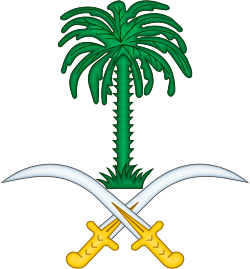Ministry of Foreign Affairs (Saudi Arabia)
The Ministry of Foreign Affairs (MOFA) (Arabic: وزارة الخارجية Wizārat al-Khārijīyah) is the ministry responsible for handling the Kingdom of Saudi Arabia's external relations. The ministry oversees "political, cultural and financial international relations" and monitors the Kingdom's diplomatic relations.[1] It was created in 1930 by a royal decree issued by King Abdulaziz Al Saud, being the first ministerial body created by the King.[2]
| وزارة الخارجية السعودية | |
.svg.png) Seal of the Ministry of Foreign Affairs of Saudi Arabia | |
| Agency overview | |
|---|---|
| Formed | 1926 |
| Preceding agency |
|
| Jurisdiction | Saudi Arabia and its diplomatic missions worldwide |
| Headquarters | Nasseriya Street, Riyadh |
| Agency executives |
|
| Child agency |
|
| Website | http://www.mofa.gov.sa/ |
 |
|---|
| This article is part of a series on the politics and government of Saudi Arabia |
|
|
| Basic Law |
|
|
Administrative divisions
|
|
|
|
History
While consolidating the newly formed Kingdom of Nejd and Hejaz, King Abdulaziz, established foreign diplomatic relations by sending representatives and receiving delegations from various states. In 1926, he established the directorate general for foreign affairs in Mecca.[2] The first director general of foreign affairs was Abdullah Beg Al Damluji, who was also ruler of Mecca at that time.[3] In 1930, a royal decree was issued to elevate the directorate general to the ministry of foreign affairs.[4] King Abdulaziz appointed his son, Prince Faisal, as the first foreign minister.[5] The Kingdom of Saudi Arabia was formally established by King Abdulaziz in 1932.
Initially the ministry was made up of five departments, namely the private office and the departments of oriental affairs, administrative affairs, political affairs and consular affairs.[2] The ministry began establishing diplomatic missions abroad. The first one was opened in Cairo in 1926 followed by another in London 1930.[2] The number of missions increased from five in 1936 to 18 in 1951 and expanded further after that.
Aside from a brief interjection, Prince Faisal continued to serve even after he succeeded the throne as King. After his assassination in 1975, Faisal was succeeded as foreign minister by his son, Prince Saud.[5] Saud was the longest-serving foreign minister of any country in current political times,[6] The ministry launched a magazine, The Diplomat, in 2007.[7]
It was rumored in 2010 that the next foreign minister would be Prince Turki Al Faisal, Saud's younger brother, after Saud retired, which however did not occur.[8]
Senior officials
The senior officials in the ministry are as follows:[9]
| Official | Rank |
|---|---|
| Faisal bin Farhan Al Saud | Minister of Foreign Affairs |
| Abdulaziz bin Abdullah | Deputy Minister of Foreign Affairs |
| Adel al-Jubeir | Minister of State for Foreign Affairs |
List of ministers
Ministers of Foreign Affairs
The following is the list of foreign ministers since its foundation:[5]
| No. | Image | Name | Took office | Left office | King |
|---|---|---|---|---|---|
| 1 |  |
Faisal bin Abdulaziz Al Saud | 19 December 1930 | 22 December 1960 | Abdulaziz (1932–1953)
Saud (1953–1964) |
| 2 |  |
Ibrahim bin Abdullah Al Suwaiyel | 22 December 1960 | 16 March 1962 | Saud (1953–1964) |
| 3 |  |
Faisal bin Abdulaziz Al Saud | 16 March 1962 | 25 March 1975 | Saud (1953–1964)
Himself (1964–1975) |
| 4 |  |
Saud bin Faisal Al Saud | 13 October 1975 | 29 April 2015 | Khalid (1975–1982) |
| 5 | .jpg) |
Adel al-Jubeir | 29 April 2015 | 27 December 2018 | Salman (2015–present) |
| 6 | .png) |
Ibrahim Abdulaziz Al-Assaf | 27 December 2018 | 23 October 2019 | Salman (2015–present) |
| 7 | Faisal bin Farhan Al Saud | 23 October 2019 | Present | Salman (2015–present) | |
Ministers of State for Foreign Affairs
The ministers of state for foreign affairs served are as follows:[3]
- Omar Al Saqqaf (1968–1974)
- Nizar Madani (2005–2018)
- Adel al-Jubeir (2018–)
Building
The building of the ministry is in Riyadh and was designed by Henning Larsen. It blends both vernacular and monumental styles of Islamic architecture.[10] Larsen received the Aga Khan Award for Architecture in 1989 for his work on the building.[10][11]
Built in 1984, building consists of meeting, conference and prayer rooms, a library and a banquet hall.[10] Externally, the building appears as a fortress that was carved out of a single piece of stone.[11]
References
- "Ministry Addresses". Royal Embassy of Saudi Arabia, Washington, DC. Archived from the original on 26 April 2011. Retrieved 30 April 2011.
- Al Kahtani, Mohammad Zaid (December 2004). "The Foreign Policy of King Abdulaziz" (PDF). University of Leeds. Retrieved 21 July 2013.
- "حول الوزارة" (in Arabic). Ministry of Foreign Affairs (Saudi Arabia). 5 May 2005. Retrieved 30 April 2011.
- Hertog, Steffen (2007). "Shaping the Saudi state: Human agency's shifting role in the rentier state formation" (PDF). International Journal of Middle East Studies. 39 (4): 539–563. doi:10.1017/S0020743807071073. Retrieved 17 April 2012.
- "Brief History". Ministry of Foreign Affairs (Saudi Arabia). 5 May 2005. Retrieved 30 April 2011.
- Slackman, Michael (9 December 2009). "A Legacy of Regret for a Saudi Diplomat". The New York Times. Retrieved 6 May 2011.
- "Diplomat". Arab Media Company. Retrieved 21 May 2012.
- Henderson, Simon (22 October 2010). "Foreign Policy: A Prince's Mysterious Disappearance". NPR. Retrieved 30 April 2011.
- "Senior Officials". Ministry of Foreign Affairs (Saudi Arabia). Retrieved 30 April 2011.
- "Ministry of Foreign Affairs". ArchNet. Archived from the original on 19 June 2010. Retrieved 30 April 2011.
- Rivas, Paul. "Islamic architecture personified by Ministry of Foreign Affairs in Riyadh". The Saudi Gazette. Archived from the original on 13 September 2012. Retrieved 30 April 2011.